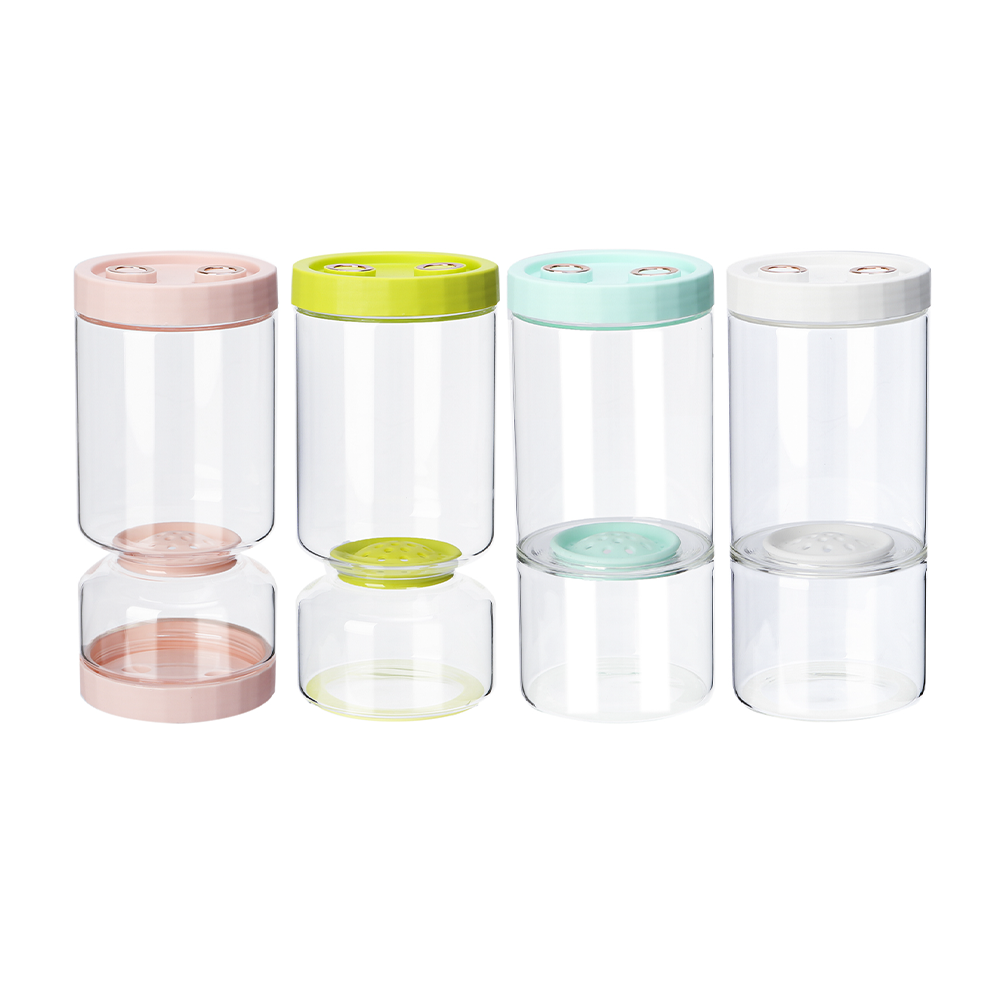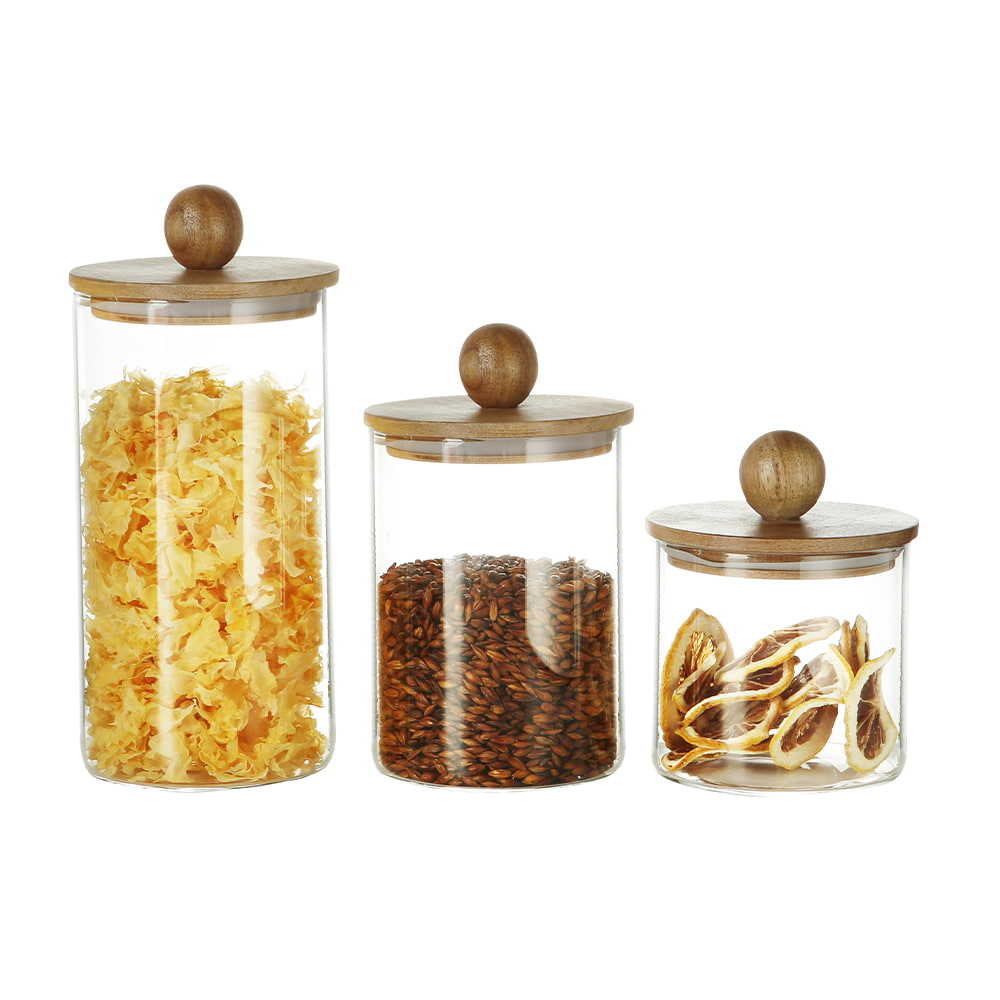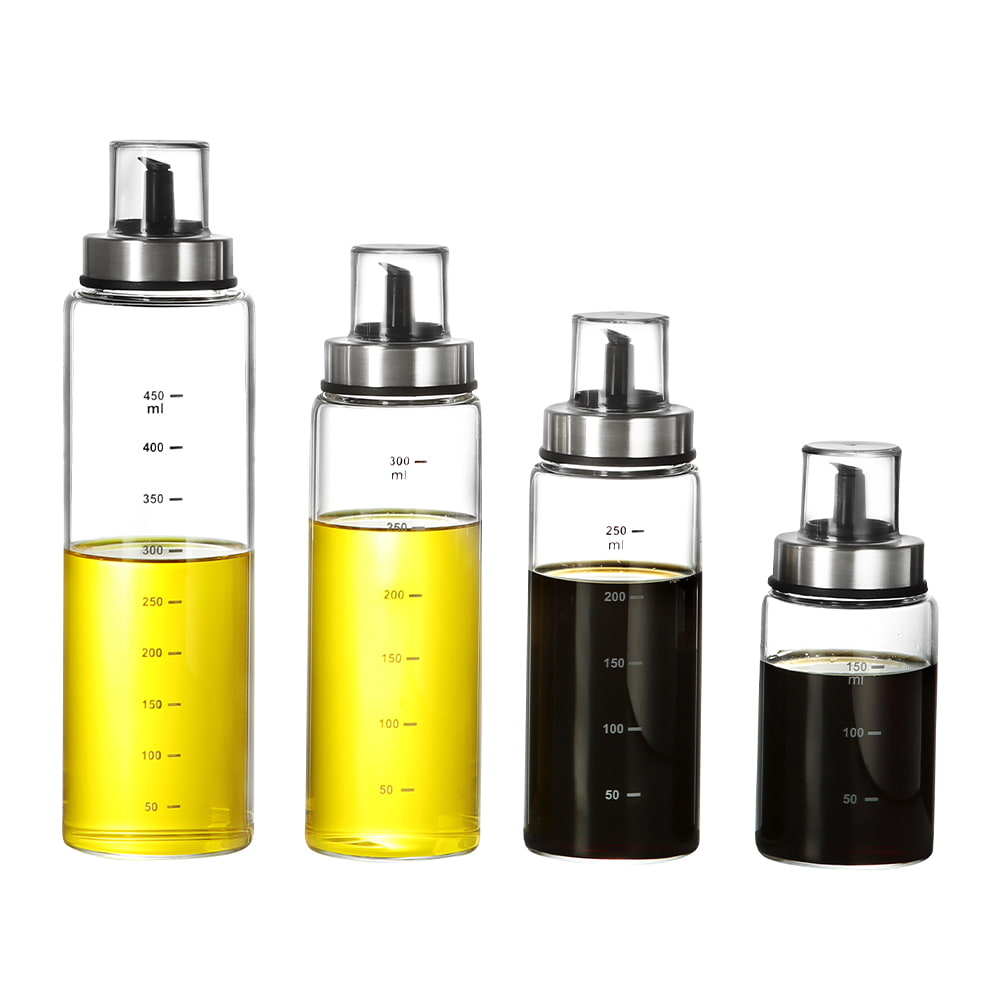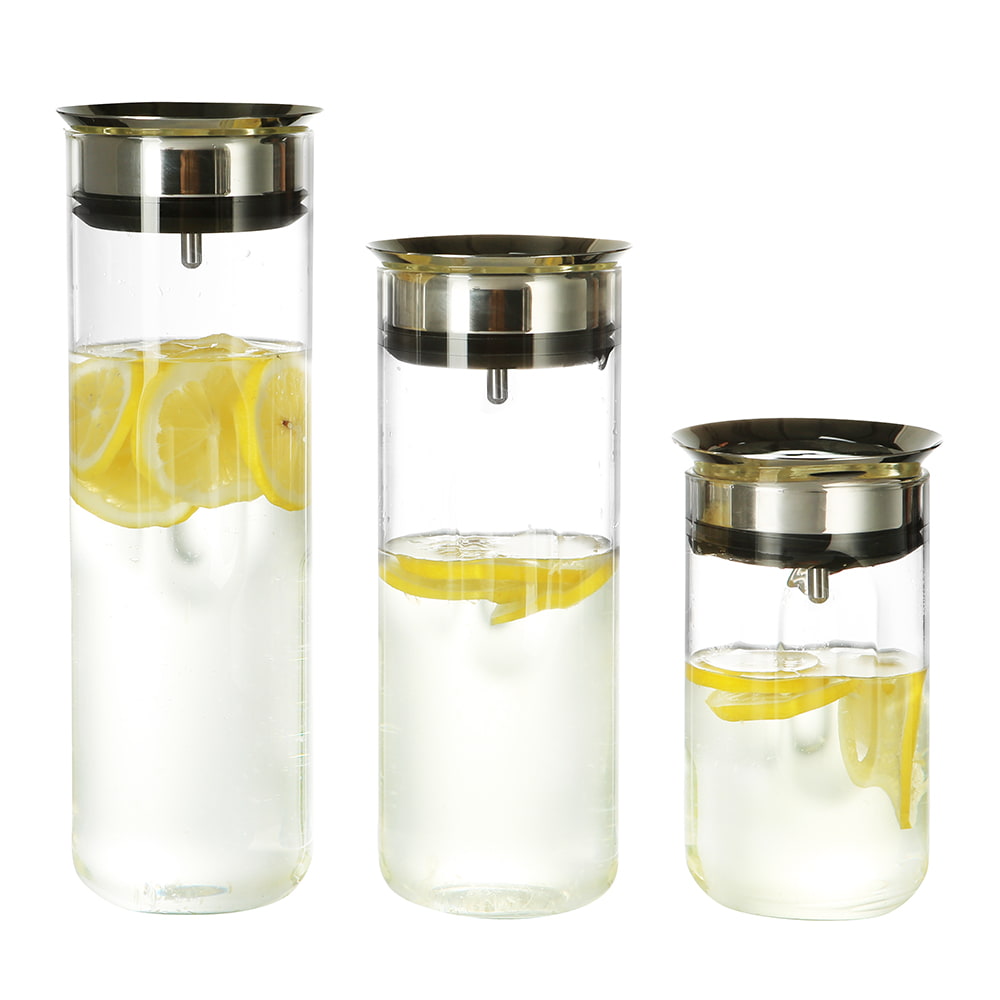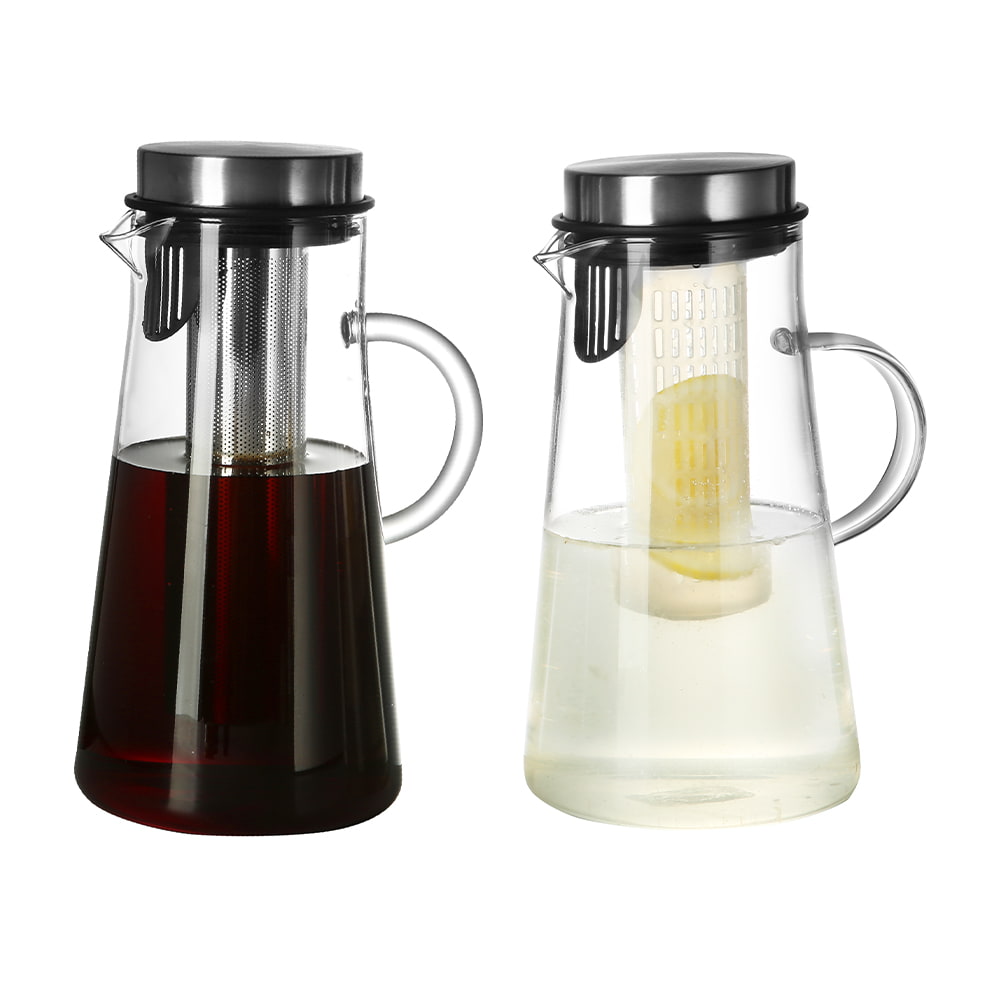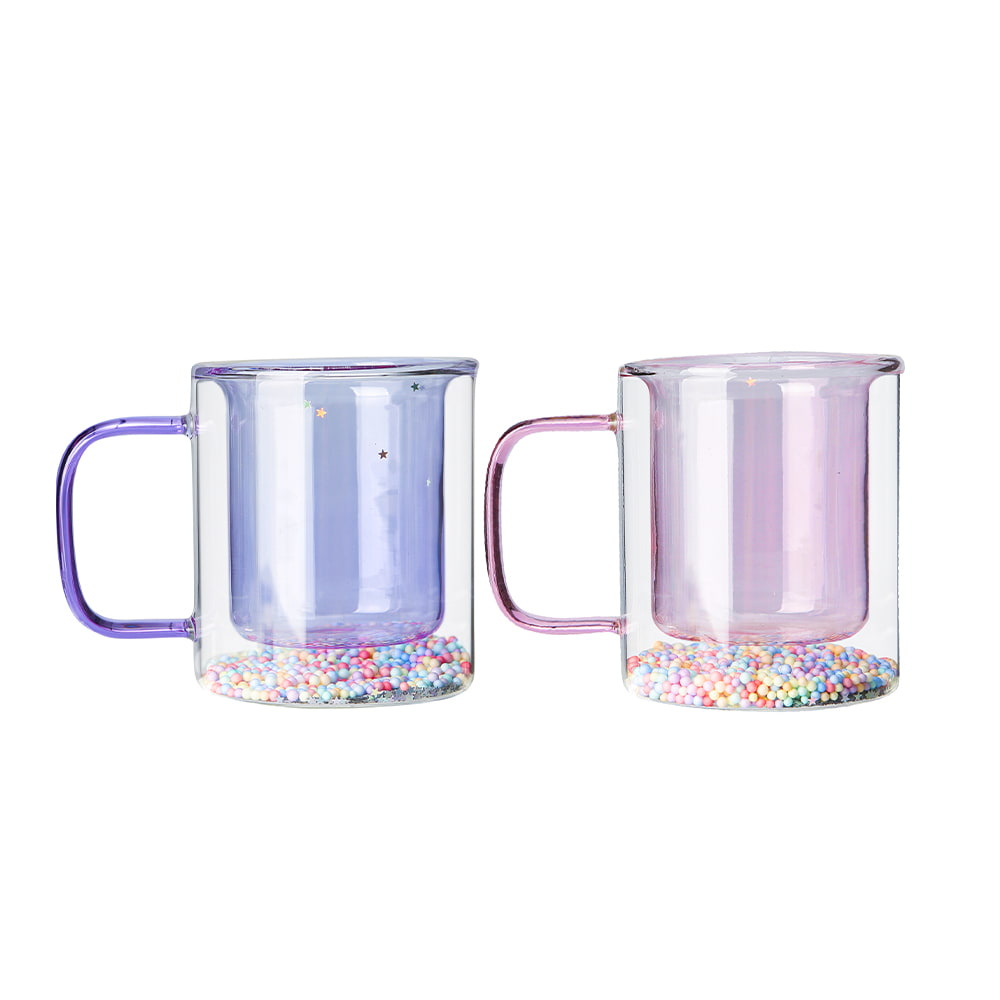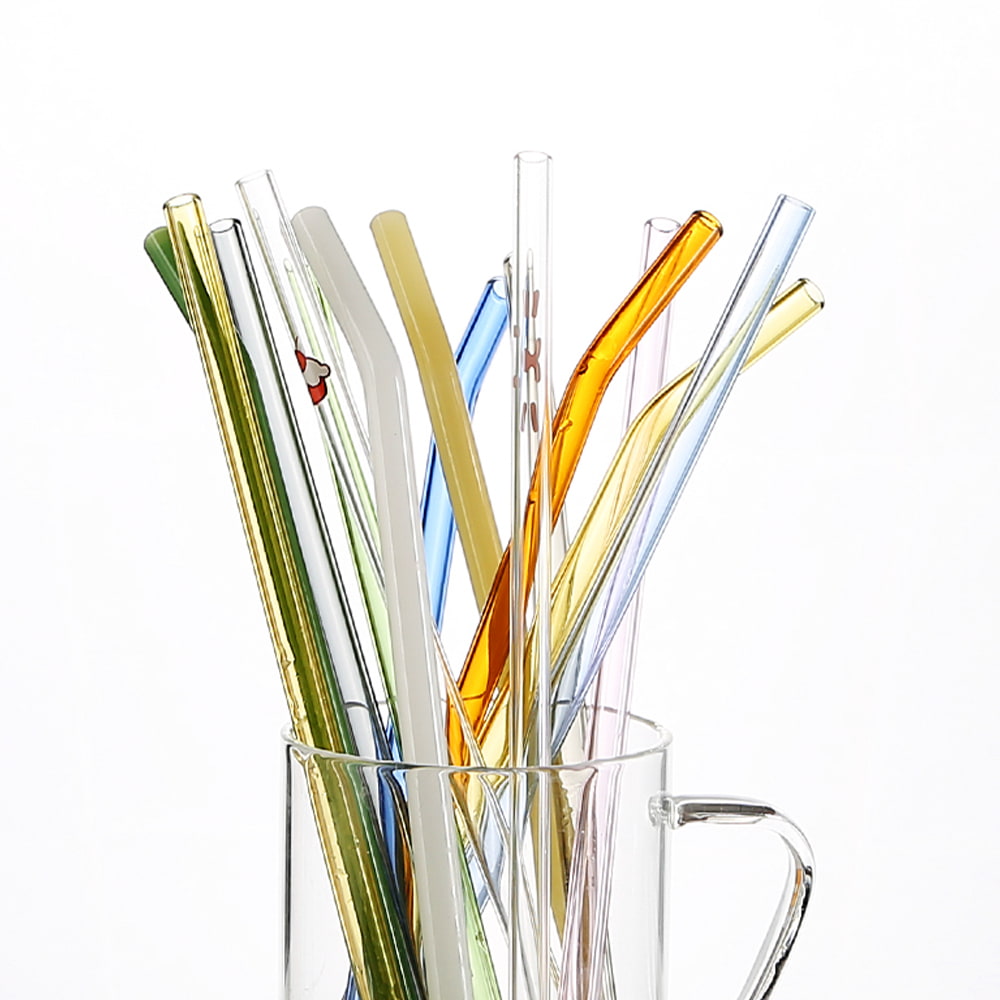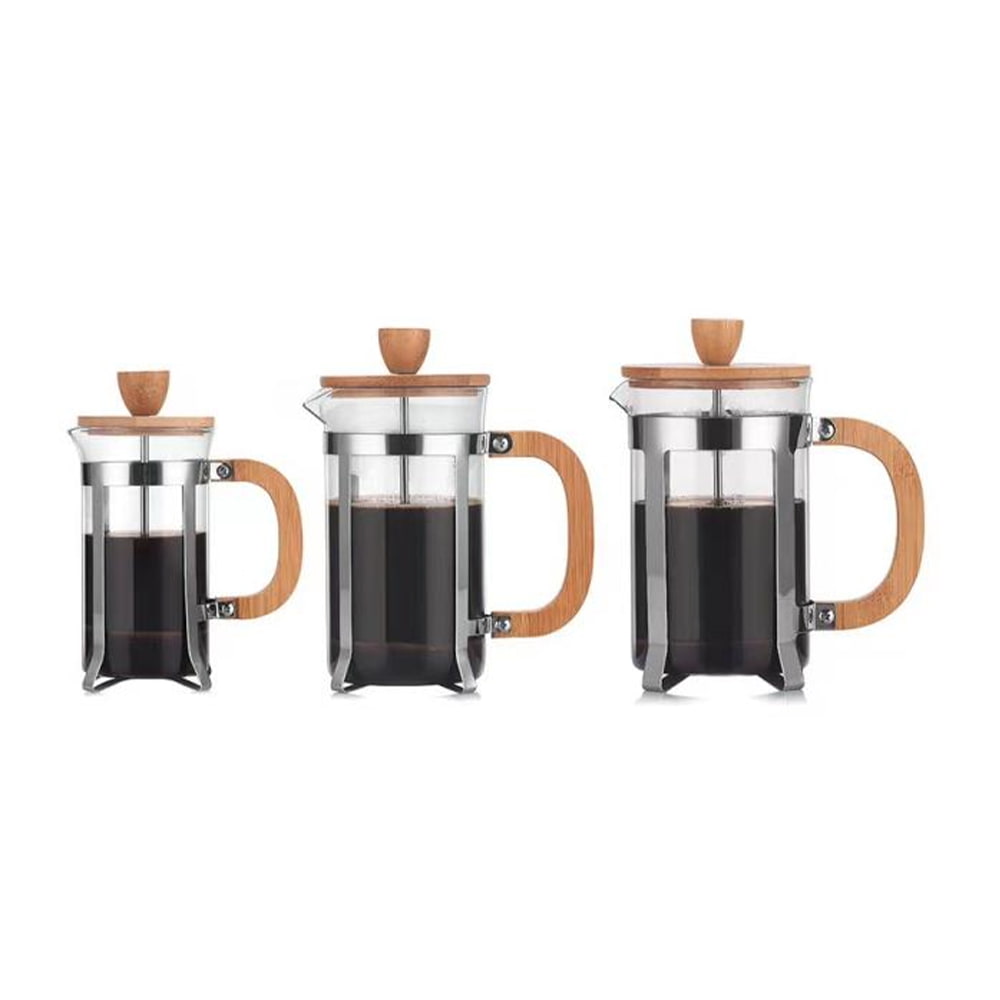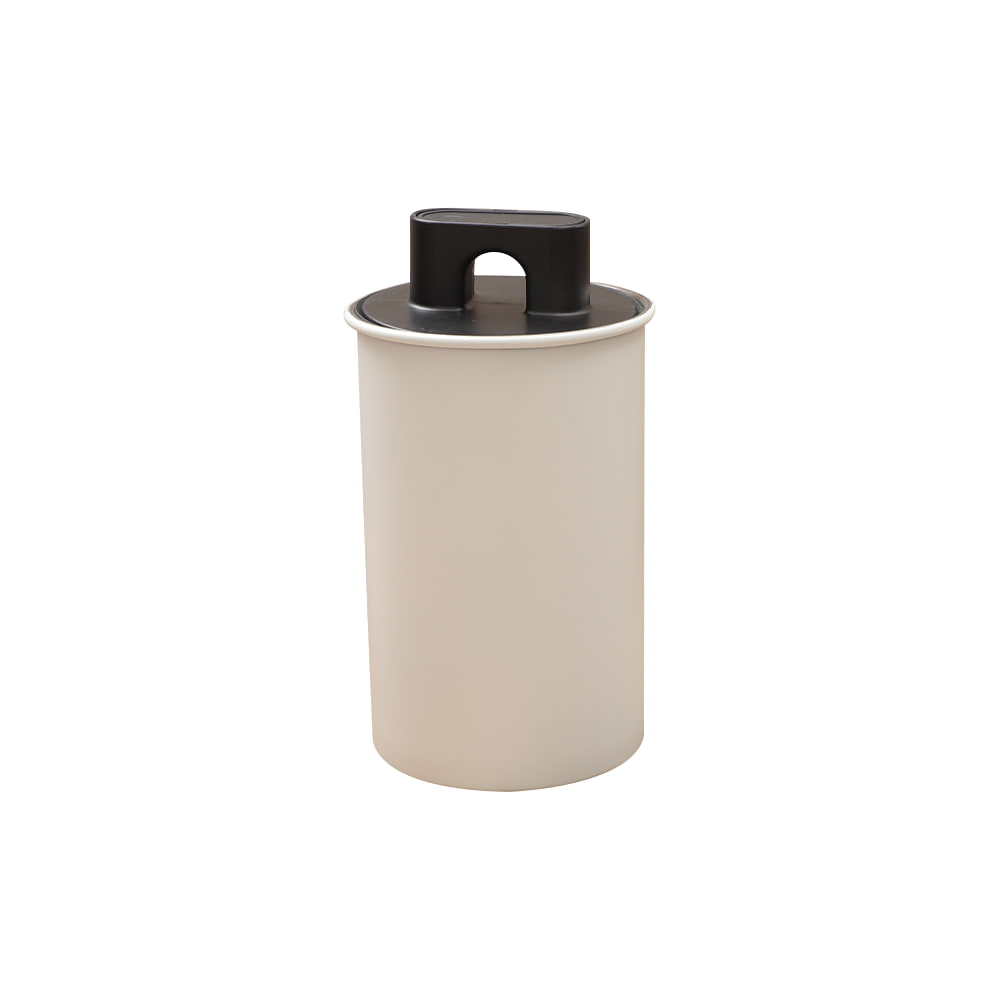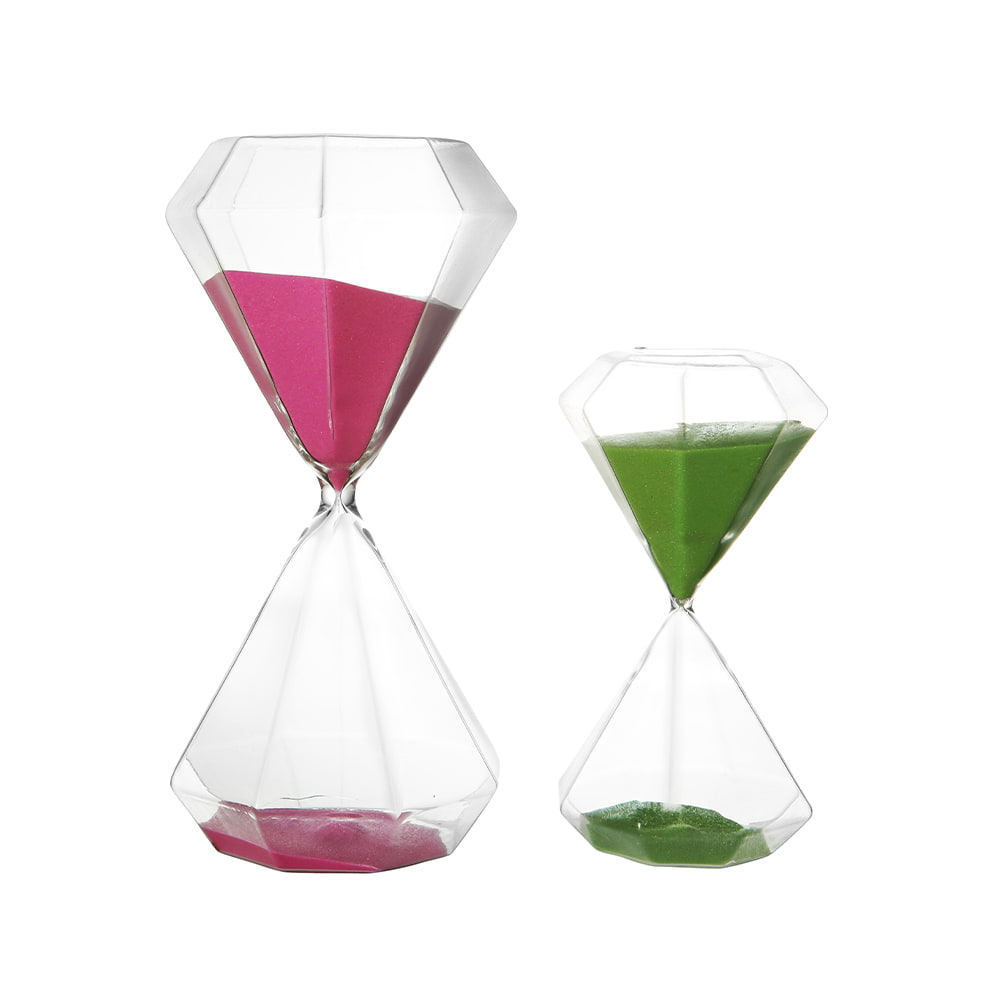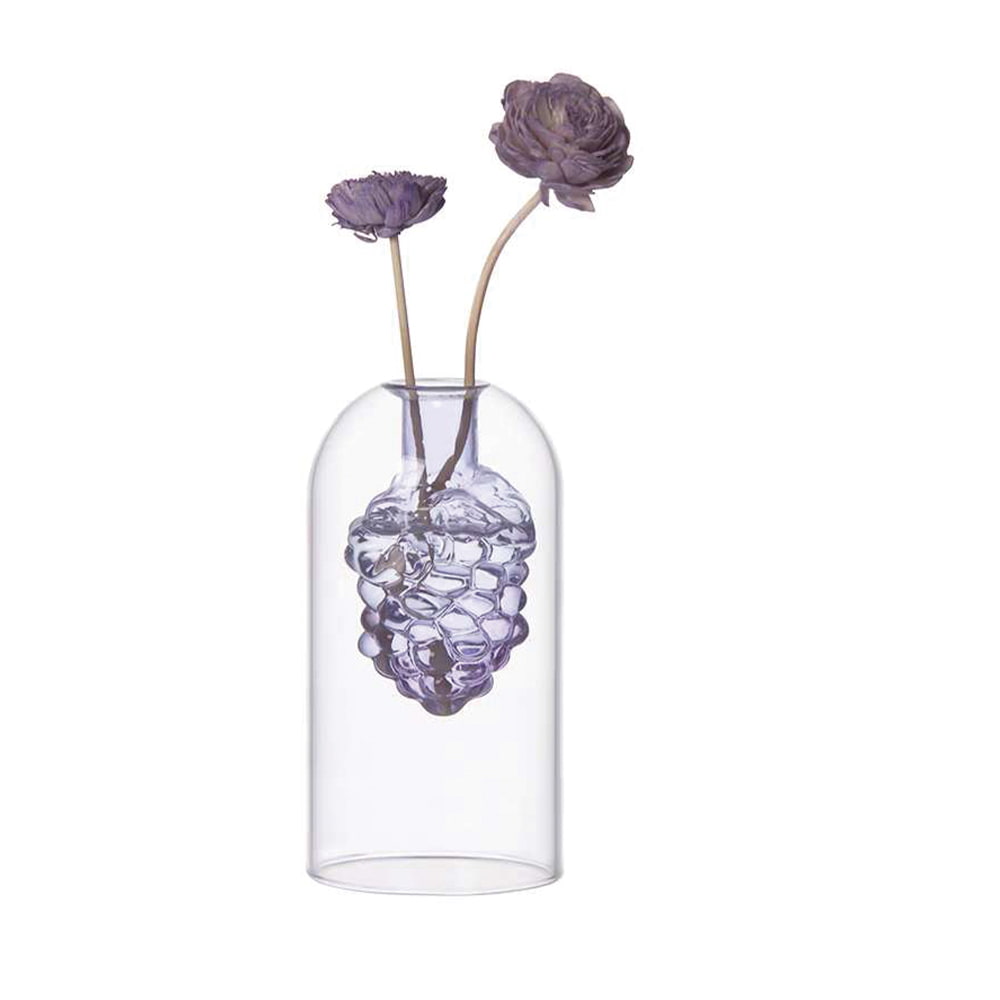 Language
Language



+86-0514-8866-8898
+86-18083766162

julia@nchousewares.com
Jack@nchousewares.com
Condiment Jar: A Comprehensive Guide to Buyer Knowledge and Usage
1. What is a Condiment Jar?
A condiment jar is a container used to store and dispense small quantities of spices, sauces, dips, or other flavorings. These jars are commonly found in kitchens, restaurants, and food service environments. They are designed to keep condiments fresh and easily accessible. The term "condiment" refers to any substance added to food to enhance its flavor, such as mustard, ketchup, soy sauce, hot sauce, or honey.
Condiment jars come in various sizes, materials, and styles, depending on the intended use. For example, a small glass jar might be used for herbs or spices, while a larger plastic jar could hold sauces or dips. The choice of material (e.g., glass, plastic, ceramic) often depends on the type of condiment and the environment in which it is used.
2. Common Uses of Condiment Jars
| Use Case | Description | Materials | Features | Examples |
| Home Kitchen | Used for storing and dispensing small quantities of spices, herbs, and condiments. | Glass, ceramic, or plastic. | Easy to clean, durable, and aesthetically pleasing. | Small glass jars for herbs, plastic jars for sauces. |
| Restaurants and Cafés | Used for self-service condiments like ketchup, mustard, and soy sauce. | Stainless steel, plastic, or glass. | Easy to clean, stackable, and color-coded. | Plastic jars with wide mouths for easy filling. |
| Commercial Kitchens | Used for bulk storage and dispensing of condiments. | Industrial-grade plastic or stainless steel. | Large capacity, durable, and easy to clean. | Large plastic jars for ketchup and mustard. |
| Event Catering | Used for buffets and parties where variety and accessibility are key. | Glass or plastic. | Attractive labels, color-coded, and stackable. | Glass jars with custom labels for different sauces. |
| Outdoor and Travel | Used for picnics, camping, or travel. | Portable, lightweight, and spill-proof. | Easy to carry and use. | Mini plastic jars for salt, pepper, and sugar. |
| Food Trucks | Used for quick and easy access to condiments. | Lightweight and durable. | Easy to clean and stackable. | Stackable plastic jars for sauces and dips. |
| Schools and Cafeterias | Used for student meals and school lunches. | Non-toxic, easy to clean, and child-friendly. | Child-friendly design and easy to use. | Plastic jars with non-slip bases. |
| Hotels and Fine Dining | Used for enhancing the dining experience. | Elegant and high-quality. | Customizable labels and color-coded. | Glass jars with custom labels for different sauces. |
| Bakeries and Pastry Shops | Used for storing and dispensing sugar, salt, and other baking ingredients. | Glass or ceramic. | Aesthetic and functional. | Glass jars with measured spoons. |
| Dessert and Ice Cream Parlors | Used for toppings and flavorings. | Glass or plastic. | Attractive and functional. | Glass jars with colorful labels for toppings. |
| Bars and Pubs | Used for serving drinks and snacks. | Stainless steel or glass. | Durable and easy to clean. | Stainless steel jars for salt and pepper. |
| Grocery Stores | Used for retail and customer use. | Various materials, including glass and plastic. | Attractive and functional. | Glass jars with custom labels for different sauces. |
| Industrial and Production Lines | Used for mass production and distribution. | Industrial-grade plastic or stainless steel. | Large capacity and easy to clean. | Industrial plastic jars for ketchup and mustard. |
Examples of Condiment Jars in Different Settings
- Home Kitchen: Glass jars for herbs and spices, plastic jars for sauces and dips.
- Restaurants: Stainless steel jars for ketchup and mustard, glass jars for soy sauce.
- Event Catering: Color-coded glass jars for different sauces and dips.
- Outdoor and Travel: Mini plastic jars for salt, pepper, and sugar.
- Food Trucks: Stackable plastic jars for sauces and dips.
- Schools and Cafeterias: Plastic jars with non-slip bases.
- Hotels and Fine Dining: Glass jars with custom labels for different sauces.
- Bakeries and Pastry Shops: Glass jars with measured spoons.
- Dessert and Ice Cream Parlors: Glass jars with colorful labels for toppings.
- Bars and Pubs: Stainless steel jars for salt and pepper.
- Grocery Stores: Glass jars with custom labels for different sauces.
- Industrial and Production Lines: Industrial plastic jars for ketchup and mustard.
3. Types of Condiment Jars
| Type of Condiment Jar | Description | Materials | Features | Examples |
| Glass Jars | Transparent and durable, suitable for storing and dispensing a wide range of condiments. | Glass | Easy to clean, dishwasher safe, and visually appealing. | Glass jars with red or black lids for salt and pepper . |
| Plastic Jars | Lightweight and cost-effective, ideal for high-volume use. | Plastic | Easy to carry and stack, suitable for commercial use. | Stackable plastic jars for sauces and dips . |
| Ceramic Jars | Elegant and decorative, suitable for home or restaurant settings. | Ceramic | Aesthetic and functional, suitable for special occasions. | Ceramic jars with custom labels for different sauces . |
| Metal Jars | Durable and resistant to breakage, suitable for industrial use. | Metal | Strong and long-lasting, suitable for heavy-duty use. | Stainless steel jars for salt and pepper . |
| Wooden Jars | Natural and rustic, suitable for home or outdoor use. | Wood | Eco-friendly and aesthetically pleasing, suitable for natural settings. | Wooden jars with metal rings for salt and pepper . |
| Stainless Steel Jars | Durable and hygienic, suitable for commercial kitchens. | Stainless Steel | Easy to clean and maintain, suitable for food service. | Stainless steel jars for ketchup and mustard . |
| Rotary Jars | Designed for easy pouring and portion control. | Glass or Plastic | Features a rotary mechanism for precise dispensing. | Rotary jars with measured spoons for sauces . |
| Sealed Jars | Designed to keep condiments fresh and prevent spoilage. | Glass, Plastic, or Metal | Airtight seals to preserve freshness and flavor. | Sealed jars with airtight lids for oil and vinegar . |
| Color-Coded Jars | Used to identify different condiments quickly. | Glass or Plastic | Color-coded labels for easy identification and organization. | Color-coded jars for different sauces and dips . |
| Mini Jars | Small in size, suitable for herbs and small portions. | Glass or Plastic | Compact and convenient for home use. | Mini glass jars for herbs and spices . |
| Large Capacity Jars | Designed for bulk storage and dispensing. | Plastic or Stainless Steel | Large volume and easy to refill. | Large plastic jars for ketchup and mustard . |
| Customizable Jars | Can be branded or labeled with custom designs. | Glass, Plastic, or Metal | Custom labels and designs for branding and personalization. | Customized jars with brand logos for restaurants . |
| Eco-Friendly Jars | Made from recycled materials and designed for sustainability. | Glass, Plastic, or Metal | Environmentally friendly and reusable. | Recycled glass jars with eco-friendly labels . |
| Specialized Jars | Designed for specific uses like oil, vinegar, or salt. | Glass or Ceramic | Specialized designs for specific condiments. | Oil and vinegar jars with narrow necks for precise pouring . |
4. How to Choose the Right Condiment Jar
| Selection Criteria | Description | Material Options | Key Features | Examples |
| Type of Condiment | Choose based on the nature of the condiment (e.g., liquid, powder, oil). | Glass, Plastic, Ceramic, Stainless Steel | Select materials that are compatible with the condiment's properties. | Glass jars for vinegar, plastic jars for salt and pepper. |
| Material | Consider the durability, safety, and compatibility with the condiment. | Glass, Plastic, Ceramic, Stainless Steel | Glass is ideal for acidic or strong-flavored condiments; plastic is suitable for light or non-acidic ones. | Glass jars for soy sauce, plastic jars for sugar. |
| Design | Consider the ease of use, visibility, and aesthetics. | Glass, Plastic, Ceramic, Stainless Steel | Look for features like easy-to-pull lids, transparent bodies, or color-coded labels. | Glass jars with color-coded labels for different sauces. |
| Capacity and Size | Choose based on usage (e.g., storage or table use). | Glass, Plastic, Ceramic, Stainless Steel | Large capacity for bulk storage, small size for tabletop use. | 1L glass jar for bulk storage, 300mL plastic jar for tabletop use. |
| Seal and Closure | Ensure the jar is sealed properly to prevent spoilage or leakage. | Glass, Plastic, Ceramic, Stainless Steel | Choose jars with airtight seals or silicone gaskets for powder or liquid condiments. | Stainless steel jars with airtight lids for salt and pepper. |
| Cleaning and Maintenance | Consider ease of cleaning and maintenance. | Glass, Plastic, Ceramic, Stainless Steel | Look for jars with removable lids or large openings for easy cleaning. | Glass jars with removable lids for easy cleaning. |
| Aesthetics and Branding | Consider the appearance and brand identity. | Glass, Plastic, Ceramic, Stainless Steel | Choose jars with custom labels or stylish designs for branding or personalization. | Customized glass jars with brand logos for restaurants. |
| Environmental Impact | Consider sustainability and eco-friendliness. | Glass, Plastic, Ceramic, Stainless Steel | Choose jars made from recycled materials or designed for reuse. | Recycled glass jars with eco-friendly labels. |
| Specialized Use | Consider specific uses like oil, vinegar, or salt. | Glass, Ceramic, Stainless Steel | Choose specialized designs for specific condiments. | Narrow-necked glass jars for oil and vinegar. |
5. How to Use Condiment Jars
| Step | Action | Materials/Tools | Purpose | Notes |
| 1. Prepare the Condiment Jar | Choose the right condiment jar based on the type of condiment and usage. | Glass, plastic, ceramic, or stainless steel jars. | Ensure the jar is suitable for the condiment and environment. | Consider factors like material, size, and design. |
| 2. Open the Jar | Remove the lid or cap from the jar. | Spatula or spoon. | Access the condiment inside the jar. | Be careful to avoid spills or contamination. |
| 3. Adjust the Opening | If the jar has a adjustable opening or nozzle, set it to the desired size. | Adjustable nozzle or spout. | Control the amount of condiment dispensed. | Adjust based on personal preference or recipe requirements. |
| 4. Dispense the Condiment | Pour or sprinkle the condiment onto the food. | Spoon, spatula, or the jar itself. | Add flavor to the dish. | Ensure even distribution for consistent taste. |
| 5. Close the Jar | Securely close the lid or cap after use. | Lid or cap. | Prevent spills and maintain freshness. | Make sure the lid is tightly sealed to prevent leaks. |
| 6. Clean the Jar | Rinse the jar with water and dry it thoroughly. | Sponge, paper towel, or dishcloth. | Maintain hygiene and prevent bacterial growth. | Use mild soap if necessary, but avoid harsh detergents that may damage the jar. |
| 7. Store the Jar | Place the jar in a cool, dry place. | Storage area. | Preserve the quality and shelf life of the condiment. | Avoid direct sunlight and high temperatures. |
Additional Tips for Using Condiment Jars
- Labeling: Use labels to identify different condiments and avoid confusion. This is especially useful in commercial settings or when multiple people are using the same kitchen.
- Regular Maintenance: Clean the jar regularly to prevent residue buildup and ensure food safety. Check for any signs of damage or wear and replace the jar if necessary.
- Portion Control: Use measured spoons or adjustable nozzles to control the amount of condiment used. This helps in maintaining consistency in recipes and reducing waste.
- Aesthetic Considerations: Choose jars that match the aesthetic of your kitchen or dining area. Customized or branded jars can enhance the overall look and feel of the space.
- Environmental Impact: Consider using eco-friendly materials and designs. Recycled glass or plastic jars are more sustainable and environmentally friendly options.
6. How to Maintain Condiment Jars
| Maintenance Step | Action | Materials/Tools | Purpose | Notes |
| 1. Clean the Jar Regularly | Remove dust, oil, and dirt from the jar. | Soap, mild detergent, warm water, sponge, paper towel, or dishcloth. | Prevent bacterial growth and maintain hygiene. | Avoid using harsh detergents that may damage the jar. |
| 2. Check for Damage | Inspect the jar for any cracks, leaks, or loose lids. | Visual inspection. | Ensure the jar is safe and functional. | Replace damaged jars immediately to prevent contamination. |
| 3. Proper Storage | Store the jar in a cool, dry place away from direct sunlight. | Storage cabinet or shelf. | Prevent spoilage and maintain the quality of the condiment. | Avoid storing near heat sources or in high-humidity areas. |
| 4. Label and Organize | Use labels to identify different condiments and organize the jars. | Labels, markers, or label maker. | Avoid confusion and ensure easy access. | Use color-coded labels for better organization. |
| 5. Avoid Overfilling | Fill the jar to the recommended level to prevent spills. | Measuring spoon or measuring cup. | Ensure consistent portion sizes and reduce waste. | Follow the manufacturer's guidelines for optimal use. |
| 6. Use Appropriate Tools | Use non-metallic tools for cleaning and handling. | Soft brush, cloth, or spatula. | Prevent scratches and damage to the jar. | Avoid using metal tools that can scratch the surface. |
| 7. Rinse and Dry Thoroughly | Rinse the jar with water and dry it completely. | Water, paper towel, or air dryer. | Prevent moisture buildup and ensure hygiene. | Ensure the jar is completely dry before storing. |
| 8. Check for Expiration | Regularly check the condiment for signs of spoilage or expiration. | Visual inspection and smell test. | Ensure the condiment is safe for consumption. | Discard any expired or spoiled condiments immediately. |
| 9. Clean the Lids and Seals | Clean the lids and seals to ensure they are airtight. | Mild soap, water, and cloth. | Prevent leaks and maintain freshness. | Ensure the lids are tightly sealed after each use. |
| 10. Store in airtight Containers | Use airtight containers for long-term storage. | Airtight lids or seals. | Prevent oxidation and maintain flavor. | Ideal for condiments like oil, vinegar, and herbs. |
| 11. Rotate Stock | Rotate the stock to ensure older condiments are used first. | Inventory list or date markers. | Prevent waste and ensure freshness. | Label each jar with the date of purchase or opening. |
| 12. Use airtight Storage for Herbs | Store fresh herbs in airtight containers with water. | Airtight jars or vases. | Keep herbs fresh and prevent wilting. | Change the water regularly to maintain freshness. |
| 13. Avoid Cross-Contamination | Use separate spoons or tools for different condiments. | Separate spoons or spatulas. | Prevent mixing of flavors and ensure hygiene. | Label each tool to avoid confusion. |
| 14. Regular Maintenance Schedule | Follow a regular maintenance schedule based on usage. | Cleaning schedule, calendar, or reminder app. | Ensure consistent care and longevity. | Adjust the schedule based on the frequency of use. |
Additional Tips for Maintaining Condiment Jars
- Use airtight seals for condiments that are prone to spoilage, such as oil, vinegar, and herbs.
- Avoid storing condiments in direct sunlight to prevent degradation and spoilage.
- Keep the kitchen clean to prevent the spread of bacteria and ensure food safety.
- Use glass jars for acidic or strong-flavored condiments to preserve their flavor and quality.
- Use plastic jars for light or non-acidic condiments to reduce the risk of breakage.
7. How to Clean Condiment Jars
| Step | Action | Materials/Tools | Purpose | Notes |
| 1. Empty the Jar | Remove all contents from the jar. | Spatula or spoon. | Prevent cross-contamination and ensure thorough cleaning. | Discard any expired or spoiled condiments before cleaning. |
| 2. Disassemble Components | Remove any removable parts like lids, nozzles, or sprayers. | Screwdriver or wrench (if needed). | Allow for more thorough cleaning of all parts. | Check for any loose parts that may need to be tightened. |
| 3. Soak in Warm Water | Place the jar and its components in warm water. | Warm water, basin or sink. | Soften and loosen any residue or buildup. | Soak for at least 10 minutes to break down stubborn residues. |
| 4. Apply Cleaning Agent | Use a mild detergent or dish soap. | Mild detergent, sponge, or brush. | Remove food particles and bacteria. | Avoid harsh chemicals that may damage the jar or its components. |
| 5. Scrub Thoroughly | Clean the inside and outside of the jar and its components. | Sponge, brush, or cloth. | Remove all traces of food and bacteria. | Pay attention to corners and crevices where residue may accumulate. |
| 6. Rinse Completely | Rinse the jar and its components with clean water. | Water, faucet, or sink. | Remove all traces of detergent and residue. | Ensure no soap or cleaning agents remain inside the jar. |
| 7. Disinfect (Optional) | Use a disinfectant solution if needed. | Disinfectant, dilution instructions. | Kill bacteria and ensure hygiene. | Follow the manufacturer's instructions for proper dilution. |
| 8. Dry Thoroughly | Allow the jar and its components to air dry. | Paper towel or clean cloth. | Prevent moisture buildup and mold growth. | Ensure all parts are completely dry before reassembly. |
| 9. Reassemble and Store | Put the components back into the jar. | Lids, nozzles, or sprayers. | Ensure the jar is ready for reuse. | Make sure all parts are securely in place. |
| 10. Label and Organize | Use labels to identify the contents of the jar. | Labels, markers, or label maker. | Prevent confusion and ensure proper use. | Use color-coded labels for better organization. |
| 11. Regular Maintenance | Follow a cleaning schedule based on usage. | Calendar, reminder app, or checklist. | Ensure consistent care and longevity. | Adjust the schedule based on the frequency of use. |
| 12. Avoid Overfilling | Fill the jar to the recommended level. | Measuring spoon or measuring cup. | Prevent spills and ensure consistent portion sizes. | Follow the manufacturer's guidelines for optimal use. |
| 13. Use Appropriate Tools | Use non-metallic tools for cleaning and handling. | Soft brush, cloth, or spatula. | Prevent scratches and damage to the jar. | Avoid using metal tools that can scratch the surface. |
| 14. Check for Expiration | Regularly check the condiment for signs of spoilage. | Visual inspection and smell test. | Ensure the condiment is safe for consumption. | Discard any expired or spoiled condiments immediately. |
| 15. Store Properly | Store the jar in a cool, dry place. | Storage cabinet or shelf. | Prevent spoilage and maintain the quality of the condiment. | Avoid direct sunlight and high-humidity areas. |
Additional Tips for Cleaning Condiment Jars
- Use airtight seals for condiments that are prone to spoilage, such as oil, vinegar, and herbs.
- Avoid storing condiments in direct sunlight to prevent degradation and spoilage.
- Keep the kitchen clean to prevent the spread of bacteria and ensure food safety.
- Use glass jars for acidic or strong-flavored condiments to preserve their flavor and quality.
- Use plastic jars for light or non-acidic condiments to reduce the risk of breakage.
8. How to Store Condiment Jars
| Storage Method | Description | Materials/Tools | Purpose | Notes |
| 1. Choose the Right Container | Select a container that is appropriate for the type of condiment. | Glass, plastic, ceramic, or stainless steel jars. | Ensure the container is suitable for the condiment's properties. | Avoid using plastic for acidic or strong-flavored condiments. |
| 2. Seal the Container | Ensure the container is sealed properly to prevent spoilage or leakage. | Airtight lids or seals. | Prevent exposure to air and moisture. | Use airtight seals for condiments like oil, vinegar, and herbs. |
| 3. Store in a Cool, Dry Place | Place the container in a cool, dry location away from direct sunlight. | Cabinet or shelf. | Prevent spoilage and maintain the quality of the condiment. | Avoid storing near heat sources or in high-humidity areas. |
| 4. Label the Container | Use labels to identify the contents of the container. | Labels, markers, or label maker. | Prevent confusion and ensure proper use. | Use color-coded labels for better organization. |
| 5. Use airtight Storage for Herbs | Store fresh herbs in airtight containers with water. | Airtight jars or vases. | Keep herbs fresh and prevent wilting. | Change the water regularly to maintain freshness. |
| 6. Avoid Overfilling | Fill the container to the recommended level. | Measuring spoon or measuring cup. | Prevent spills and ensure consistent portion sizes. | Follow the manufacturer's guidelines for optimal use. |
| 7. Use Appropriate Tools | Use non-metallic tools for cleaning and handling. | Soft brush, cloth, or spatula. | Prevent scratches and damage to the container. | Avoid using metal tools that can scratch the surface. |
| 8. Check for Expiration | Regularly check the condiment for signs of spoilage. | Visual inspection and smell test. | Ensure the condiment is safe for consumption. | Discard any expired or spoiled condiments immediately. |
| 9. Store in the Refrigerator | Store certain condiments in the refrigerator to extend their shelf life. | Refrigerator. | Prevent spoilage and maintain freshness. | Ideal for condiments like oil, vinegar, and herbs. |
| 10. Rotate Stock | Rotate the stock to ensure older condiments are used first. | Inventory list or date markers. | Prevent waste and ensure freshness. | Label each container with the date of purchase or opening. |
| 11. Avoid Cross-Contamination | Use separate spoons or tools for different condiments. | Separate spoons or spatulas. | Prevent mixing of flavors and ensure hygiene. | Label each tool to avoid confusion. |
| 12. Use airtight Storage for Long-Term Storage | Use airtight containers for long-term storage. | Airtight lids or seals. | Prevent oxidation and maintain flavor. | Ideal for condiments like oil, vinegar, and herbs. |
| 13. Store in a Well-Ventilated Area | Store the container in a well-ventilated area to prevent mold and bacteria growth. | Ventilation system or air flow. | Ensure the container is not exposed to excessive moisture. | Avoid storing in poorly ventilated areas. |
| 14. Use airtight Storage for High-Acid Condiments | Use airtight containers for high-acid condiments like vinegar and lemon juice. | Airtight lids or seals. | Prevent oxidation and maintain flavor. | Ideal for condiments that are prone to spoilage. |
| 15. Use airtight Storage for High-Oil Condiments | Use airtight containers for high-oil condiments like olive oil and vegetable oil. | Airtight lids or seals. | Prevent rancidity and maintain freshness. | Ideal for condiments that are prone to oxidation. |
Additional Tips for Storing Condiment Jars
- Use glass jars for acidic or strong-flavored condiments to preserve their flavor and quality.
- Avoid storing condiments in direct sunlight to prevent degradation and spoilage.
- Keep the kitchen clean to prevent the spread of bacteria and ensure food safety.
- Use plastic jars for light or non-acidic condiments to reduce the risk of breakage.
9. Common Mistakes When Using Condiment Jars
9.1 Overfilling the Jar
- Problem: Overfilling can cause spills or leaks, especially if the jar has a loose lid.
- Solution: Always fill the jar to the recommended level to avoid messes.
9.2 Not Cleaning the Jar Regularly
- Problem: Bacterial growth can occur if the jar is not cleaned regularly.
- Solution: Clean the jar after each use and dry it thoroughly.
9.3 Using the Wrong Type of Jar for the Condiment
- Problem: Using a glass jar for a thick sauce can cause breakage, while using a plastic jar for a dry spice can cause contamination.
- Solution: Choose the right type of jar based on the type of condiment.
10. Environmental and Sustainability Considerations
10.1 Eco-Friendly Options
- Recycled Materials: Some manufacturers use recycled glass or plastic to reduce environmental impact.
- Reusable Jars: Reusable jars are eco-friendly and can be refilled multiple times.
10.2 Disposal and Recycling
- Proper Disposal: Jars should be disposed of properly to avoid pollution.
- Recycling: Many plastic and glass jars are recyclable, so check with your local recycling program.
11. Cultural and Historical Context of Condiment Jars
11.1 Historical Use
- Ancient Times: In ancient civilizations, jars were used to store spices, herbs, and condiments.
- Modern Era: In the 20th century, plastic and glass jars became popular for household and commercial use.
11.2 Cultural Significance
- Culinary Traditions: In many cultures, condiment jars are an essential part of daily meals.
- Global Variations: Different countries and regions have their own unique condiments and jars.
12. Common Condiments and Their Jar Requirements
| Condiment | Type | Material Requirements | Jar Features | Usage Tips |
| Salt | Dry | Glass, ceramic, or plastic | Airtight seal, non-metallic lid | Store in airtight containers to prevent clumping. Avoid direct sunlight. |
| Sugar | Dry | Glass or ceramic | Airtight seal, wide mouth for easy scooping | Store in a dry, cool place to prevent hardening. |
| Pepper | Dry | Glass or ceramic | Airtight seal, non-metallic lid | Store in airtight containers to maintain freshness. |
| Mustard | Liquid | Glass or plastic | Wide mouth, easy-to-pull lid | Store in a cool, dark place to preserve flavor. |
| Ketchup | Liquid | Glass or plastic | Wide mouth, easy-to-pull lid | Store in a cool, dark place to prevent spoilage. |
| Soy Sauce | Liquid | Glass or ceramic | Airtight seal, narrow neck | Store in a cool, dark place to maintain flavor. |
| Honey | Liquid | Glass or plastic | Airtight seal, wide mouth | Store in a cool, dark place to prevent crystallization. |
| Olive Oil | Liquid | Glass or ceramic | Airtight seal, narrow neck | Store in a cool, dark place to prevent rancidity. |
| Vinegar | Liquid | Glass or ceramic | Airtight seal, narrow neck | Store in a cool, dark place to preserve acidity. |
| Hot Sauce | Liquid | Glass or plastic | Easy-to-pull lid, wide mouth | Store in a cool, dark place to maintain heat and flavor. |
| Rice Vinegar | Liquid | Glass or ceramic | Airtight seal, narrow neck | Store in a cool, dark place to preserve acidity. |
| Tomato Sauce | Liquid | Glass or plastic | Easy-to-pull lid, wide mouth | Store in a cool, dark place to prevent spoilage. |
| Mayonnaise | Semi-liquid | Glass or plastic | Airtight seal, narrow neck | Store in a cool, dark place to prevent spoilage. |
| Mustard Seed | Dry | Glass or ceramic | Airtight seal, non-metallic lid | Store in airtight containers to maintain freshness. |
| Cumin | Dry | Glass or ceramic | Airtight seal, non-metallic lid | Store in airtight containers to maintain flavor. |
| Paprika | Dry | Glass or ceramic | Airtight seal, non-metallic lid | Store in airtight containers to maintain color and flavor. |
| Garlic Powder | Dry | Glass or ceramic | Airtight seal, non-metallic lid | Store in airtight containers to prevent clumping. |
| Onion Powder | Dry | Glass or ceramic | Airtight seal, non-metallic lid | Store in airtight containers to maintain freshness. |
| Chili Flakes | Dry | Glass or ceramic | Airtight seal, non-metallic lid | Store in airtight containers to maintain heat and flavor. |
| Herbs (e.g., Basil, Parsley) | Dry | Glass or ceramic | Airtight seal, water reservoir | Store in a glass jar with water to keep fresh. |
Additional Notes
- Glass Jars: Ideal for acidic or strong-flavored condiments like vinegar, oil, and mustard to preserve flavor and prevent contamination.
- Plastic Jars: Suitable for light or non-acidic condiments like sugar and pepper, but avoid using for acidic or strong-flavored condiments.
- Airtight Seals: Essential for condiments like salt, sugar, and herbs to prevent moisture and air exposure.
- Wide Mouths: Convenient for easy scooping and cleaning, especially for dry condiments.
- Narrow Necks: Ideal for condiments like oil and vinegar to prevent spills and maintain freshness.
- Non-Metallic Lids: Recommended for dry condiments to prevent oxidation and maintain flavor.
- Storage Location: Store all condiments in a cool, dark, and dry place to maintain quality and extend shelf life.
13. Common Problems with Condiment Jars and How to Fix Them
13.1 Leaking Jars
- Cause: Poorly sealed lids or overfilling.
- Solution: Check the lid seal and replace if necessary. Use spoons or inserts to prevent overfilling.
13.2 Mold or Spoilage
- Cause: Improper storage, infected condiments, or damaged jars.
- Solution: Discard any spoiled condiments and clean the jar thoroughly before reuse.
13.3 Broken Glass Jars
- Cause: Accidental drops or pressure.
- Solution: Replace the jar immediately and use a plastic alternative for similar condiments.
14. Tips for Choosing the Right Condiment Jar for Your Needs
14.1 For Home Use
- Glass Jars: Ideal for herbs, spices, and liquids that need to be kept fresh and visible.
- Ceramic Jars: Great for decorative use or special occasions.
- Plastic Jars: Good for high-volume use or children’s use.
14.2 For Restaurants and Cafés
- Plastic or Stainless Steel Jars: Durable and easy to clean.
- Custom Labels: Help brand the restaurant and reduce confusion.
- Large Capacity: Necessary for high-traffic areas.
14.3 For Commercial Kitchens
- Industrial-Grade Jars: Designed for heavy use and hygiene.
- Bulk Storage: Essential for large-scale operations.
- Easy-to-Clean Design: Important for food safety and efficiency.
15. Safety Tips for Using Condiment Jars
| Safety Tip | Description | Materials/Tools | Purpose | Notes |
| 1. Choose the Right Material | Select containers made from non-toxic and BPA-free materials such as glass, ceramic, or food-grade plastic. | Glass, ceramic, or PP (Polypropylene) plastic jars. | Prevent health risks and ensure food safety. | Avoid using plastic bottles for acidic or strong-flavored condiments like oil, vinegar, or mustard . |
| 2. Ensure Proper Sealing | Use airtight seals to prevent exposure to air and moisture. | Airtight lids or seals. | Maintain the freshness and quality of the condiment. | Check for any leaks or damage to the seal before use . |
| 3. Store in a Cool, Dry Place | Keep the jars in a cool, dark, and dry location to prevent spoilage and degradation. | Cabinet or shelf. | Extend the shelf life of the condiment. | Avoid storing near heat sources or in high-humidity areas . |
| 4. Avoid Overfilling | Fill the jar to the recommended level to prevent spills. | Measuring spoon or measuring cup. | Ensure consistent portion sizes and reduce waste. | Follow the manufacturer's guidelines for optimal use . |
| 5. Use Appropriate Tools | Use non-metallic tools for cleaning and handling to prevent scratches and damage. | Soft brush, cloth, or spatula. | Maintain the integrity of the jar and its contents. | Avoid using metal tools that can scratch the surface . |
| 6. Regular Cleaning and Maintenance | Clean the jar regularly to prevent bacterial growth and ensure hygiene. | Mild detergent, water, sponge, or cloth. | Maintain the cleanliness and safety of the jar. | Rinse thoroughly and dry completely before reassembly . |
| 7. Check for Expiration | Regularly check the condiment for signs of spoilage or expiration. | Visual inspection and smell test. | Ensure the condiment is safe for consumption. | Discard any expired or spoiled condiments immediately . |
| 8. Avoid Cross-Contamination | Use separate spoons or tools for different condiments. | Separate spoons or spatulas. | Prevent mixing of flavors and ensure hygiene. | Label each tool to avoid confusion . |
| 9. Avoid Using Plastic Bottles for Certain Condiments | Do not use plastic bottles for acidic or strong-flavored condiments like oil, vinegar, or mustard. | Glass or ceramic jars. | Prevent the release of harmful substances into the food. | Use plastic bottles only for non-acidic condiments like sugar or salt . |
| 10. Avoid High Temperatures | Do not expose the jars to high temperatures or sudden temperature changes. | Thermometer or temperature-controlled environment. | Prevent the jar from breaking or releasing harmful substances. | Avoid placing hot liquids into a cold glass jar or vice versa . |
| 11. Keep Out of Reach of Children | Store the jars in a secure location to prevent accidental ingestion. | Child-proof lids or cabinet locks. | Ensure safety and prevent misuse. | Especially important for small or breakable jars . |
| 12. Use airtight Storage for Long-Term Storage | Use airtight containers for long-term storage to prevent oxidation and maintain flavor. | Airtight lids or seals. | Ideal for condiments like oil, vinegar, and herbs. | Helps preserve the quality and safety of the condiment . |
| 13. Rotate Stock | Rotate the stock to ensure older condiments are used first. | Inventory list or date markers. | Prevent waste and ensure freshness. | Label each container with the date of purchase or opening . |
| 14. Use airtight Storage for High-Acid Condiments | Use airtight containers for high-acid condiments like vinegar and lemon juice. | Airtight lids or seals. | Prevent oxidation and maintain flavor. | Ideal for condiments that are prone to spoilage . |
| 15. Use airtight Storage for High-Oil Condiments | Use airtight containers for high-oil condiments like olive oil and vegetable oil. | Airtight lids or seals. | Prevent rancidity and maintain freshness. | Ideal for condiments that are prone to oxidation . |
16. Environmental Impact of Condiment Jars
16.1 Plastic vs. Glass
- Plastic Jars: More lightweight and durable, but less recyclable.
- Glass Jars: More recyclable and eco-friendly, but heavier and more fragile.
16.2 Sustainability Initiatives
- Recycled Materials: Many manufacturers now use recycled glass and plastic to reduce waste.
- Reusable Jars: Encouraging reusable jars can reduce the need for single-use plastics.
17. Cultural and Regional Variations in Condiment Jars
17.1 Asian Cuisine
- Soy Sauce and Vinegar: Commonly stored in glass jars with tight-fitting lids.
- Fish Sauce and Nước Chấm: Often kept in ceramic or glass jars for preservation.
17.2 Mediterranean Cuisine
- Olive Oil and Vinegar: Stored in glass jars for preservation and presentation.
- Herbs and Spices: Often kept in small glass jars for daily use.
17.3 American Cuisine
- Ketchup and Mustard: Commonly found in glass or plastic jars in restaurants and homes.
- Hot Sauce: Available in various jar sizes and flavors.
18. How to Choose the Right Condiment Jar for a Restaurant or Café
| Selection Criteria | Description | Material Options | Key Features | Examples |
| Type of Condiment | Choose based on the nature of the condiment (e.g., liquid, powder, oil). | Glass, Plastic, Ceramic, Stainless Steel | Select materials that are compatible with the condiment's properties. | Glass jars for vinegar, plastic jars for sugar. |
| Material | Consider the durability, safety, and compatibility with the condiment. | Glass, Plastic, Ceramic, Stainless Steel | Glass is ideal for acidic or strong-flavored condiments; plastic is suitable for light or non-acidic ones. | Glass jars for soy sauce, plastic jars for salt and pepper. |
| Design | Consider the ease of use, visibility, and aesthetics. | Glass, Plastic, Ceramic, Stainless Steel | Look for features like easy-to-pull lids, transparent bodies, or color-coded labels. | Glass jars with color-coded labels for different sauces. |
| Capacity and Size | Choose based on usage (e.g., storage or table use). | Glass, Plastic, Ceramic, Stainless Steel | Large capacity for bulk storage, small size for tabletop use. | 1L glass jar for bulk storage, 300mL plastic jar for tabletop use. |
| Seal and Closure | Ensure the jar is sealed properly to prevent spoilage or leakage. | Glass, Plastic, Ceramic, Stainless Steel | Choose jars with airtight seals or silicone gaskets for powder or liquid condiments. | Stainless steel jars with airtight lids for salt and pepper. |
| Cleaning and Maintenance | Consider ease of cleaning and maintenance. | Glass, Plastic, Ceramic, Stainless Steel | Look for jars with removable lids or large openings for easy cleaning. | Glass jars with removable lids for easy cleaning. |
| Aesthetics and Branding | Consider the appearance and brand identity. | Glass, Plastic, Ceramic, Stainless Steel | Choose jars with custom labels or stylish designs for branding or personalization. | Customized glass jars with brand logos for restaurants. |
| Environmental Impact | Consider sustainability and eco-friendliness. | Glass, Plastic, Ceramic, Stainless Steel | Choose jars made from recycled materials or designed for reuse. | Recycled glass jars with eco-friendly labels. |
| Specialized Use | Consider specific uses like oil, vinegar, or salt. | Glass, Ceramic, Stainless Steel | Choose specialized designs for specific condiments. | Narrow-necked glass jars for oil and vinegar. |
Additional Tips for Choosing Condiment Jars for a Restaurant or Café
- Use glass jars for acidic or strong-flavored condiments to preserve their flavor and quality.
- Avoid using plastic bottles for certain condiments like oil, vinegar, or mustard to prevent the release of harmful substances into the food.
- Ensure airtight seals for condiments like salt, sugar, and herbs to prevent moisture and air exposure.
- Provide color-coded labels for different condiments to enhance organization and reduce confusion.
- Choose sturdy and durable designs for commercial use to withstand frequent handling and ensure longevity.
- Consider the size and capacity based on the restaurant's needs, whether it's for bulk storage or tabletop use.
- Prioritize hygiene and safety by selecting materials that are non-toxic and easy to clean.
19. How to Choose the Right Condiment Jar for a Kitchen
| Selection Criteria | Description | Material Options | Key Features | Examples |
| Type of Condiment | Choose based on the nature of the condiment (e.g., liquid, powder, oil). | Glass, Plastic, Ceramic, Stainless Steel | Select materials that are compatible with the condiment's properties. | Glass jars for vinegar, plastic jars for sugar. |
| Material | Consider the durability, safety, and compatibility with the condiment. | Glass, Plastic, Ceramic, Stainless Steel | Glass is ideal for acidic or strong-flavored condiments; plastic is suitable for light or non-acidic ones. | Glass jars for soy sauce, plastic jars for salt and pepper. |
| Design | Consider the ease of use, visibility, and aesthetics. | Glass, Plastic, Ceramic, Stainless Steel | Look for features like easy-to-pull lids, transparent bodies, or color-coded labels. | Glass jars with color-coded labels for different sauces. |
| Capacity and Size | Choose based on usage (e.g., storage or table use). | Glass, Plastic, Ceramic, Stainless Steel | Large capacity for bulk storage, small size for tabletop use. | 1L glass jar for bulk storage, 300mL plastic jar for tabletop use. |
| Seal and Closure | Ensure the jar is sealed properly to prevent spoilage or leakage. | Glass, Plastic, Ceramic, Stainless Steel | Choose jars with airtight seals or silicone gaskets for powder or liquid condiments. | Stainless steel jars with airtight lids for salt and pepper. |
| Cleaning and Maintenance | Consider ease of cleaning and maintenance. | Glass, Plastic, Ceramic, Stainless Steel | Look for jars with removable lids or large openings for easy cleaning. | Glass jars with removable lids for easy cleaning. |
| Aesthetics and Branding | Consider the appearance and brand identity. | Glass, Plastic, Ceramic, Stainless Steel | Choose jars with custom labels or stylish designs for branding or personalization. | Customized glass jars with brand logos for restaurants. |
| Environmental Impact | Consider sustainability and eco-friendliness. | Glass, Plastic, Ceramic, Stainless Steel | Choose jars made from recycled materials or designed for reuse. | Recycled glass jars with eco-friendly labels. |
| Specialized Use | Consider specific uses like oil, vinegar, or salt. | Glass, Ceramic, Stainless Steel | Choose specialized designs for specific condiments. | Narrow-necked glass jars for oil and vinegar. |
Additional Tips for Choosing Condiment Jars for a Kitchen
- Use glass jars for acidic or strong-flavored condiments to preserve their flavor and quality .
- Avoid using plastic bottles for certain condiments like oil, vinegar, or mustard to prevent the release of harmful substances into the food .
- Ensure airtight seals for condiments like salt, sugar, and herbs to prevent moisture and air exposure .
- Provide color-coded labels for different condiments to enhance organization and reduce confusion .
- Choose sturdy and durable designs for commercial use to withstand frequent handling and ensure longevity .
- Consider the size and capacity based on the household's needs, whether it's for bulk storage or tabletop use .
- Prioritize hygiene and safety by selecting materials that are non-toxic and easy to clean .
20. How to Choose the Right Condiment Jar for a Commercial Kitchen
20.1 Durability and Hygiene
- Stainless Steel or Plastic: These materials are resistant to breakage and easy to clean.
- Sealable Lids: Ensure airtight seals to prevent contamination and maintain freshness.
- Large Capacity: Choose large jars to reduce the frequency of refills and minimize downtime.
20.2 Ease of Use and Maintenance
- Spout Design: Look for spout designs that allow for easy pouring and prevent spills.
- Stackable Jars: Opt for stackable jars to save space and reduce clutter.
- Non-Slip Bases: Use jars with non-slip bases to prevent tipping and ensure safety.
21. How to Choose the Right Condiment Jar for a Catering Event
21.1 Portion Control and Variety
- Measured Spoons: Include measured spoons to ensure consistent portion sizes.
- Multiple Sizes: Offer various jar sizes to cater to different appetites.
- Custom Labels: Use custom labels to brand the event and enhance the presentation.
21.2 Aesthetics and Presentation
- Elegant Jars: Choose elegant jars to match the event’s theme and enhance the dining experience.
- Color Coding: Use color-coded jars to identify different condiments quickly and reduce confusion.
- Decorative Elements: Add decorative elements like ribbons or labels to enhance the visual appeal.
22. How to Choose the Right Condiment Jar for a School or Cafeteria
22.1 Safety and Hygiene
- Non-Toxic Materials: Ensure jars are made from non-toxic materials to prevent health risks.
- Easy to Clean: Choose jars that are easy to clean to maintain hygiene.
- Child-Friendly Design: Opt for child-friendly designs to prevent spills and accidents.
22.2 Cost-Effectiveness and Durability
- Bulk Purchases: Buy large quantities to reduce costs and ensure consistent supply.
- Durable Materials: Choose durable materials that can withstand frequent use.
- Teacher-Friendly Features: Include features like spout lids to reduce mess and make cleanup easier.
23. How to Choose the Right Condiment Jar for a Hotel or Hotel Restaurant
23.1 Professionalism and Branding
- Custom Labels: Use custom labels to brand the hotel and enhance the guest experience.
- Professional Appearance: Choose jars that match the hotel’s branding and maintain a professional look.
- Consistency: Ensure consistent quality and presentation across all guest rooms and dining areas.
23.2 Durability and Maintenance
- High-Quality Materials: Use high-quality materials that can withstand heavy use.
- Easy to Clean: Choose jars that are easy to clean to maintain hygiene and efficiency.
- Staff-Friendly Design: Include features like spout lids to reduce staff workload and ensure smooth operations.
24. How to Choose the Right Condiment Jar for a Coffee Shop or Bakery
24.1 Aesthetics and Branding
- Custom Labels: Use custom labels to brand the coffee shop or bakery and enhance the customer experience.
- Elegant Design: Choose elegant jars that match the brand’s aesthetic and enhance the overall look.
- Color Coding: Use color-coded jars to identify different condiments quickly and reduce confusion.
24.2 Functionality and Portion Control
- Measured Spoons: Include measured spoons to ensure consistent portion sizes.
- Stackable Jars: Opt for stackable jars to save space and reduce clutter.
- Non-Slip Bases: Use jars with non-slip bases to prevent tipping and ensure safety.
25. How to Choose the Right Condiment Jar for a Bar or Pub
25.1 Aesthetics and Branding
- Custom Labels: Use custom labels to brand the bar or pub and enhance the customer experience.
- Elegant Design: Choose elegant jars that match the bar’s aesthetic and enhance the overall look.
- Color Coding: Use color-coded jars to identify different condiments quickly and reduce confusion.
25.2 Durability and Maintenance
- High-Quality Materials: Use high-quality materials that can withstand heavy use.
- Easy to Clean: Choose jars that are easy to clean to maintain hygiene and efficiency.
- Staff-Friendly Design: Include features like spout lids to reduce staff workload and ensure smooth operations.
26. How to Choose the Right Condiment Jar for a Food Truck or Mobile Vendor
26.1 Portability and Durability
- Lightweight Materials: Choose lightweight materials to reduce the weight of the food truck.
- Durable Design: Opt for durable designs that can withstand the rigors of travel.
- Easy to Clean: Choose jars that are easy to clean to maintain hygiene and efficiency.
26.2 Aesthetics and Branding
- Custom Labels: Use custom labels to brand the food truck and enhance the customer experience.
- Elegant Design: Choose elegant jars that match the brand’s aesthetic and enhance the overall look.
- Color Coding: Use color-coded jars to identify different condiments quickly and reduce confusion.
27. How to Choose the Right Condiment Jar for a Farmers Market or Farmers’ Market Vendor
27.1 Aesthetics and Branding
- Custom Labels: Use custom labels to brand the vendor and enhance the customer experience.
- Elegant Design: Choose elegant jars that match the brand’s aesthetic and enhance the overall look.
- Color Coding: Use color-coded jars to identify different condiments quickly and reduce confusion.
27.2 Durability and Maintenance
- High-Quality Materials: Use high-quality materials that can withstand the rigors of the market.
- Easy to Clean: Choose jars that are easy to clean to maintain hygiene and efficiency.
- Staff-Friendly Design: Include features like spout lids to reduce staff workload and ensure smooth operations.
28. How to Choose the Right Condiment Jar for a Grocery Store or Supermarket
28.1 Aesthetics and Branding
- Custom Labels: Use custom labels to brand the store and enhance the customer experience.
- Elegant Design: Choose elegant jars that match the store’s aesthetic and enhance the overall look.
- Color Coding: Use color-coded jars to identify different condiments quickly and reduce confusion.
28.2 Functionality and Customer Experience
- User-Friendly Design: Choose jars with easy-to-pull lids or spout designs to reduce spills and enhance customer satisfaction.
- Portion Control: Use measured spoons or dispensing tools to ensure consistent portion sizes and reduce waste.
29. How to Choose the Right Condiment Jar for a Hotel Restaurant or Fine Dining Establishment
29.1 Aesthetics and Branding
- Custom Labels: Use custom labels to brand the restaurant and enhance the dining experience.
- Elegant Design: Choose elegant jars that match the restaurant’s ambiance and enhance the overall look.
- Color Coding: Use color-coded jars to identify different condiments quickly and reduce confusion.
29.2 Durability and Maintenance
- High-Quality Materials: Use high-quality materials that can withstand heavy use.
- Easy to Clean: Choose jars that are easy to clean to maintain hygiene and efficiency.
- Staff-Friendly Design: Include features like spout lids to reduce staff workload and ensure smooth operations.
30. Future Trends in Condiment Jars
| Trend | Description | Key Features | Examples | |
| 1. Environmental Sustainability | The use of eco-friendly and recyclable materials in condiment jar packaging is becoming increasingly popular. | Biodegradable plastics, recycled glass, and sustainable coatings. | Brands using recycled glass jars and biodegradable plastic lids. | |
| 2. Smart Technology Integration | Integration of IoT and smart features into condiment jars to enhance user experience and convenience. | Smart lids with sensors, app connectivity, and automatic dispensing. | Smart jars that notify users when it's time to refill or replace the condiment. | |
| 3. Personalization and Customization | Consumers are increasingly seeking personalized and customizable products. | Custom labels, colors, and designs tailored to individual preferences. | Jars with custom logos, colors, and even 3D-printed designs. | |
| 4. Multi-Functional Design | Jars are being designed to serve multiple purposes, enhancing their utility. | Integrated tools like spoons, spatulas, and measuring spoons. | Jars with built-in dispensers and storage compartments. | |
| 5. Miniaturization and Portability | Smaller, more compact jars are gaining popularity due to the rise of home cooking and convenience. | Small-sized jars for tabletop use and travel. | 200-300ml jars for home use and portable condiment sets. | |
| 6. Enhanced Aesthetics and Branding | The visual appeal of condiment jars is being emphasized to attract consumers. | Color-coded labels, stylish designs, and brand-specific aesthetics. | Jars with branded logos and modern, minimalist designs. | |
| 7. Improved Sealing and Preservation | Advanced sealing technologies are being developed to extend the shelf life of condiments. | Airtight seals, vacuum packaging, and antimicrobial coatings. | Jars with vacuum-sealed lids and antimicrobial coatings. | |
| 8. Health and Safety Focus | There is a growing emphasis on the safety and health aspects of condiment jars. | Non-toxic materials, BPA-free plastics, and food-grade coatings. | Jars made from BPA-free plastics and non-toxic coatings. | |
| 9. Digital Marketing and E-commerce | The rise of e-commerce and digital marketing is changing how condiment jars are sold. | Online platforms, social media marketing, and targeted advertising. | Brands using social media and online platforms to promote their products. | |
| 10. Cross-Industry Collaboration | Collaboration between different industries to create innovative condiment jar solutions. | Partnerships with food brands, tech companies, and sustainability organizations. | Smart jars developed in collaboration with tech companies. |
Additional Notes
- Environmental Sustainability: The use of eco-friendly materials is driven by increasing consumer awareness of environmental issues and the push for sustainable practices.
- Smart Technology Integration: Smart jars are becoming more common, especially in commercial and high-end residential settings, where precision and convenience are valued.
- Personalization and Customization: The trend towards personalization reflects the growing demand for unique and tailored products, especially among younger consumers.
- Miniaturization and Portability: Smaller jars are ideal for home use and travel, making them popular among busy individuals and those who cook on the go.
- Enhanced Aesthetics and Branding: The visual appeal of condiment jars is a key factor in consumer choice, especially in retail and hospitality settings.
- Improved Sealing and Preservation: Advanced sealing technologies help preserve the quality and freshness of condiments, reducing waste and improving consumer satisfaction.
- Health and Safety Focus: The use of non-toxic and BPA-free materials ensures that consumers are using safe and healthy products.
- Digital Marketing and E-commerce: The rise of online platforms and digital marketing has opened new avenues for condiment jar brands to reach consumers.
- Cross-Industry Collaboration: Collaboration between different industries can lead to innovative solutions and new product features, enhancing the overall value proposition of condiment jars.
Recommended Products
 English
English  日本語
日本語  Deutsch
Deutsch  Español
Español 

